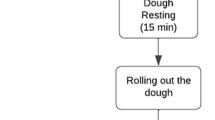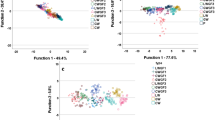Abstract
Caulerpa macrodisca and Caulerpa lentillifera, green macroalgae consumed as fresh salads in Malaysian communities esteemed for their robust nutritional profile, were investigated for their viability in dried seaweed sheet production. This study comprehensively analyzed the proximate composition and amino acid content of both species before incorporating them into dried seaweed sheet formulations. An organoleptic test, involving 50 diverse panellists, evaluated characteristics such as appearance, aroma, texture, taste, colour, and overall satisfaction. Three formulations, denoted as sample A (50% C. lentillifera and 50% C. macrodisca), sample B (100% C. lentillifera), and sample C (100% C. macrodisca), were created, and compared with a commercially available dried seaweed sheet (Sample D). The proximate analysis revealed that C. lentillifera contained 12.47±0.06% moisture, 39.18±0.29% ash, 1.76±0.09% crude lipid, 11.35±0.24% crude protein, 23.99±0.95% crude fiber, and 35.24±0.59% carbohydrate, while C. macrodisca exhibited 8.99±0.25% moisture, 34.14±1.65% ash, 0.78±0.09% crude lipid, 21.51±0.44% crude protein, 19.70±0.82% crude fiber, and 34.57±2.12% carbohydrate. Amino acid analysis identified 16 amino acids, with phenylalanine being the highest for both species (C. lentillifera: 16.54±1.41 mg g-1, C. macrodisca: 20.96±0.27 mg g-1). The organoleptic test indicated that sample A achieved the highest overall satisfaction and texture scores, whereas sample C excelled in taste characteristics. Sample B received the lowest scores across all attributes. Consequently, this study suggests that the dried seaweed sheet formulated with a combination of both species (sample A) is favoured by most panellists, demonstrating its potential for commercialization as a wholesome and appealing snack.



Similar content being viewed by others
Data availability and materials
All datasets used for supporting the conclusions of this article will be available upon request.
References
Abduh M, Maulana A, Zaitun S (2018) Substitution trial of red seaweed (Porphyra) with green grass jelly (Cyclea barbata Miers) in making nori. Adv Econ Bus Man Res 52:274–281
AOAC (2000) Official methods of analysis of AOAC International, 17th edn. The Association of Official Analytical Chemists, Gaithersburg
Bhuyar P, Rahim MH, Sundararaju S, Maniam GP, Govindan N (2020) Antioxidant and antibacterial activity of red seaweed Kappaphycus alvarezii against pathogenic bacteria. Glob J Envi Sci Manage 6:47–58
Chambers IV, Koppel K (2013) Associations of volatile compounds with sensory aroma and flavor: The complex nature of flavor. Molecules 18:4887–4905
Chan PT, Matanjun P (2017) Chemical composition and physicochemical properties of tropical red seaweed, Gracilaria changii. Food Chem 15:302–310
de Gaillande C, Payri C, Remoissenet G, Zubia M (2017) Caulerpa consumption, nutritional value and farming in the Indo-Pacific region. J App Phycol 29:2249–2266
Ferdouse F, Holdt SL, Smith R, Murúa P, Yang Z (2018) The global status of seaweed production, trade and utilization. FAO Globefish Res Prog 124:1–114
Feroz, B (2018) Saponins from marine macroalgae: a review. J Mar Sci Res Dev 8(4):1000255
Fleurence J, Morançais M, Dumay J, Decottignies P, Turpin V, Munier M, Garcia-Bueno N, Jaouen P (2012) What are the prospects for using seaweed in human nutrition and for marine animals raised through aquaculture? Tren Food Sci Tech 27(1):57–61
Fong P, Paul VJ (2011) Coral reef algae. In: Dubinsky Z, Stambler S (eds) Coral reefs: an ecosystem in transition. Springer, Dordrecht, pp 241–272
Ganesan AR, Subramani K, Shanmugam M, Seedevi P, Park S, Alfarhan AH, Rajagopal R, Balasubramanian B (2020) A comparison of nutritional value of underexploited edible seaweeds with recommended dietary allowances. J King Saud Univ Sci 32:1206–1211
Guiry MD, Guiry GM (2021) AlgaeBase. World-wide electronic publication, National University of Ireland, Galway. https://www.algaebase.org. Accessed 15 Nov 2021
Holdt SL, Kraan S (2011) Bioactive compounds in seaweed: Functional food applications and legislation. J App Phycol 23:543–97
Ismail BP (2017) Ash content determination. In: Nielsen SS (ed) Food Analysis Laboratory Manual. Springer, Cham, pp 117–119
Jayakody MM, Vanniarachchy MPG, Wijesekara I (2019) Composition analysis of selected Sri Lankan seaweeds. J Trop Env 9(2):93–100
Kılınç B, Cirik S, Turan G, Tekogul H, Koru E (2013) Seaweeds for food and industrial applications. In: Muzzalupo I (ed) Food industry. IntechOpen, Riejeka, pp 735–748
Leandro A, Pacheco D, Cotas J, Marques JC, Pereira L, Gonçalves AMM (2020) Seaweed’s bioactive candidate compounds to food industry and global food security. Life (Basel) 10:140
Matanjun P, Mohamed S, Mustapha NM, Muhammad K (2009) Nutrient content of tropical edible seaweeds, Eucheuma cottonii, Caulerpa lentillifera and Sargassum polycystum. J Appl Phycol 21:75–80
McCrickerd K, Forde CG (2016) Sensory influences on food intake control: Moving beyond palatability. Obes Rev 17:18–29
McGee H (2020) Nose dive: a field guide to the world’s smells. Penguin Press, New York, p 688
McHugh DJ (2003) A guide to the seaweed industry. FAO Fisheries Technical Paper 441. Food and Agriculture Organization of the United Nations, Rome
Mirzayeva C, Castro R, Barroso CG, Durán-Guerrero E (2021) Characterization and differentiation of seaweeds on the basis of their volatile composition. Food Chem 336:127725
Mouritsen OG, Rhatigan P, Pérez-Lloréns JL (2018) World cuisine of seaweeds: Science meets gastronomy. Inter J Gastron Food Sci 14:55–65
Mouritsen OG, Rhatigan P, Pérez-Lloréns JL (2019) The rise of seaweed gastronomy: phycogastronomy. Bot Mar 62(3):195–209
Muñoz IL, Díaz NF (2020) Minerals in edible seaweed: health benefits and food safety issues. Crit Rev Food Sci 62(6):1592–1607
Murata M, Nakazoe JI (2001) Production and use of marine algae in Japan. Jap Ag Res Quart 35:281–290
Nagappan T, Vairappan C (2014) Nutritional and bioactive properties of three edible species of green algae, genus Caulerpa (Caulerpaceae). J Appl Phycol 26:1019–1027
Noor NM, VijayaRatinam A, Ramah L (2011) Volatile compound extraction using Solid phase micro extraction coupled with gas chromatography mass spectrometry (SPME-GCMS) in local seaweeds of Kappaphycus alvarezii, Caulerpa lentillifera and Sargassum polycystum. Int Food Res J 18:1449–1456
Nguyen TV, Le NH, Lin SM, Steen F, De Clerck O (2013) Checklist of the marine macroalgae of Vietnam. Bot Mar 56:207–227
Pattara RF, Paiva L, Neto AI, Lima E, Baptista J (2011) Nutritional value of selected macroalgae. J Appl Phycol 23:205–208
Pérez-Lloréns JL, Hernández I, Brun FG, Vergara JJ, León A (2018) Those curious and delicious seaweeds A fascinating voyage from biology to gastronomy. UCA Press, University of Cadiz Publication Services, Spain, p 356
Phang SM (2006) Seaweed resources in Malaysia: Current status and future prospects. Aquat Ecol Health Manage 9:185–202
Pradana GB, Prabowo KB, Hastuti RP, Djaeni M, Prasetyaningrum A (2019) Seaweed drying process using tray dryer with dehumidified air system to increase efficiency of energy and quality product. IOP Conf Ser: Earth Environ Sci 292:012070
Razali M, Rozaiman M, Laizani N, Mohammad SM, Zawawi N (2019) Application of seaweed (Kappaphycus alvarezii) in Malaysian food products. Int Food Res J 26:1677–1687
Rachmawati W (2020) Pengembangan Klorofil Dari Daun Singkong Sebagai Pewarna Makanan Alami [Development of chlorophyll from cassava leaves as a natural food colorant]. Pharma 2:87–97
Raja K, Kadirvel V, Subramaniyan T (2022) Seaweeds, an aquatic plant-based protein for sustainable nutrition - a review. Future Foods 5:100142
Sari DK, Rahardjanto A, Purwanti E, Permana TI, Fauzi A (2019) The formulation of artificial nori with the base mixture ingredients of Gracilaria sp. and Arenga pinnata (Wurmb) Merr. using the natural colorant from Pleomele angustifolia (Medik.) NE Br IOP Conf Ser Earth Environ Sci 276(1):012013
Sayuti K, Yenrina R, Anggraini T (2017) Characteristics of “Kolang-kaling” (Sugar palm fruit jam) with added natural colorants. Pak J Nutr 16:69–76
Schanda J (2004) Expectations and the food industry: The impact of color and appearance. Col Res App 29:247–247
Sinurat E, Nurhayati N, Fransiska D, Sihono S (2021) Substitution of red seaweed (Porphyra) with other seaweeds in nori making. IOP Conf Ser: Earth Environ Sci 733:012109
Sinaga P (2018) Studi penerimaan konsumen terhadap nori rumput laut (Gracilaria sp.) dengan penambahan pewarna alami daun suji (Pleomele angustifolia). Fakultas Perikanan Dan Kelautan, Universitas Riau, Pekanbaru
Spence C, Okajima K, Cheok AD, PetitMichel OC (2016) Eating with our eyes: From visual hunger to digital satiation. Brain Cog 110:53–63
Stuthmann LE, Du HT, Brix da Costa B, Kunzmann A, Springer K (2023) Sea grape (Caulerpa lentillifera) aquaculture in Van Phong Bay, Viet Nam: evaluation of the post-harvest quality. J Appl Phycol 2023:1–12. https://doi.org/10.1007/s10811-023-03030-y
Urlass S, Wu Y, Nguyen TTL, Winberg P, Turner MS, Smyth H (2023) Unravelling the aroma and flavour of algae for future food applications. Trends Food Sci Technol 138:370–381
Wells ML, Potin P, Craigie JS, Raven JA, Merchant SS, Helliwell KE, Brawley SH (2017) Algae as nutritional and functional food sources: revisiting our understanding. J Appl Phycol 29:949–982
Yin W, Hewson L, Linforth R, Taylor M, Fisk ID (2017) Effects of aroma and taste, independently or in combination, on appetite sensation and subsequent food intake. Appetite 114:265–274
Zuldin WH, Shapawi R, Shaleh SRM, Kadar NA, Lal MTM (2019a) First occurrence of Caulerpa macrodisca (Caulerpaceae, Chlorophyta) in Malaysia based on the molecular and morphological evidence. Malay J Sci 38:72–83
Zuldin WH, Shaleh SRM, Shapawi R (2019b) Growth, biomass yield, and proximate composition of sea vegetable, Caulerpa macrodisca (Bryopsidales, Chlorophyta) cultured in tank. Phil J Sci 148:1–6
Zubia M, Draisma SGA, Morissey KL, Varela-Alvarez E, De Clerck O (2020) Concise review of the genus Caulerpa J.V. Lamoroux J Appl Phycol 32:23–39
Zuldin WH, Shapawi R, Shaleh SRM (2021) Biochemical composition of enigmatic green macroalgae, Caulerpa macrodisca Decaisne (Bryopsidales, Chlorophyta). J Appl Phycol 34:589–596
Funding
This project was funded under the Universiti Malaysia Sabah UMS New Lecturer Grant Scheme (Grant No. SLB2003) providing funds for consumables and monthly sampling expenses.
Author information
Authors and Affiliations
Contributions
W.H.Z: Formal analysis, Data curation, performed the experiment, analyzed the data and writing the manuscript draft. N.F.H: Writing, editing and reviewing the manuscript draft. N.A.A: Facilitating data collection and analysis. E.M.M: Aided in manuscript preparation. All authors have read and approved the final manuscript.
Corresponding author
Ethics declarations
This project complied with the Researcher’s Guidelines on Code of Practice for the Care and Use of Animals for Scientific Purposes set by Universiti Malaysia Sabah. Every participants involved with the organoleptic sensory evaluation test provided consent upon completion of the forms.
Competing interests
The authors declare no competing interests.
Additional information
Publisher's Note
Springer Nature remains neutral with regard to jurisdictional claims in published maps and institutional affiliations.
Rights and permissions
Springer Nature or its licensor (e.g. a society or other partner) holds exclusive rights to this article under a publishing agreement with the author(s) or other rightsholder(s); author self-archiving of the accepted manuscript version of this article is solely governed by the terms of such publishing agreement and applicable law.
About this article
Cite this article
Zuldin, W.H., Halid, N.F.A., Aming, N.A. et al. Production of dried seaweed sheet using edible green macroalgae, Caulerpa macrodisca Decaisne and Caulerpa lentillifera J. Agardh (Bryopsidales, Chlorophyta). J Appl Phycol 36, 1545–1554 (2024). https://doi.org/10.1007/s10811-024-03195-0
Received:
Accepted:
Published:
Issue Date:
DOI: https://doi.org/10.1007/s10811-024-03195-0




